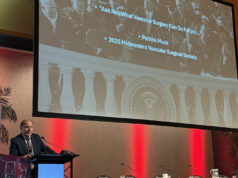Surgical augmented intelligence in the form of 3D mapping during complex aortic procedures can decrease radiation exposure, fluoroscopy time and contrast use when combined with real-time fluoroscopic images, a new analysis has established
The results were presented during the 2022 Western Vascular Society (WVS) annual meeting in Victoria, Canada (Sept. 17–20), by Rohini Patel, MD, from the University of California San Diego. The researchers aimed to flesh out whether surgical augmented intelligence can be used to decrease radiation exposure in the operating room.
The retrospective chart review, from 2015–2021, looked at 116 patients who underwent a complex aortic repair—with 76 receiving a procedure using augmented intelligence. The majority underwent physician-modified endograft (PMEG) repair.
“Our group that was treated with augmented intelligence had almost half the amount of radiation exposure, with 1,955mGy compared to 3,755mGy in the non-augmented intelligence group,” Patel told WVS.
The former also saw a decrease in fluoroscopy time of around 56 minutes compared to 87 minutes in the latter group of patients, with contrast use significantly decreased to 122cc from 199cc, she added.
Adjusted analysis showed these significant reductions remained, Patel explained. “Overall, we believe that surgical augmented intelligence is a way to decrease radiation exposure for the entire team and should be further investigated,” she said.













This is great to see and aligned with our findings at Karve, intra-procedural AI helps map complex vascular architecture halving fluoroscopy use and radiation exposure for patients and the team. Introducing this to Interventional Radiology and Endovascuar Suites can enable quicker and safer procedures, improving outcomes and maximising output.